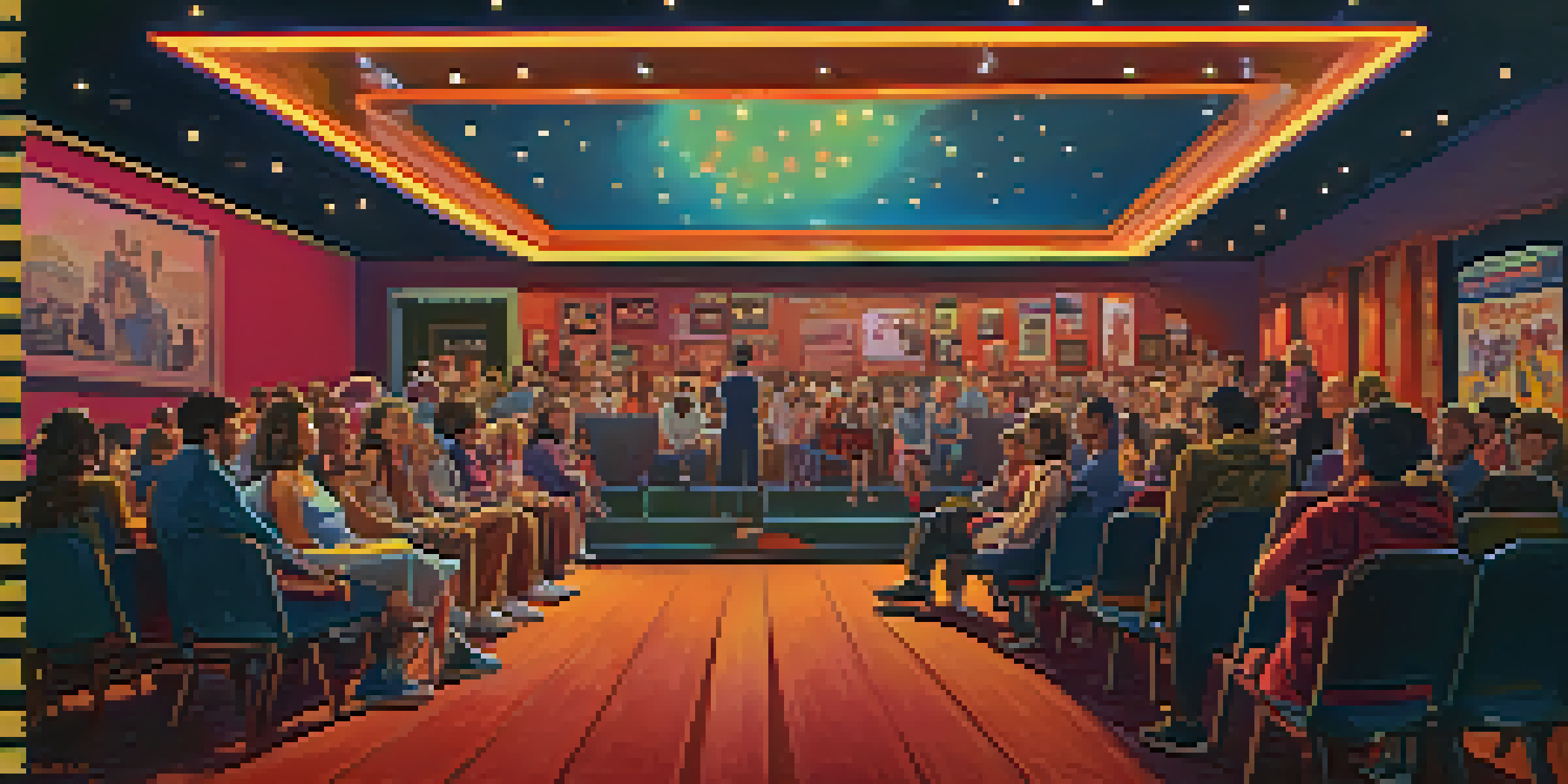The Rise of Cult Films: Understanding Their Unique Appeal

What Defines a Cult Film and Its Characteristics
Cult films are often characterized by their passionate, dedicated fanbase and unconventional storytelling. Unlike mainstream movies, they may feature quirky plots, offbeat characters, or a unique aesthetic that sets them apart. These films often challenge societal norms, making them resonate with audiences looking for something different.
Cult movies are like a secret language, and when you find someone who speaks it, you instantly connect.
Take 'The Rocky Horror Picture Show', for example; its campy humor and interactive midnight screenings have created a community of devoted fans. Similarly, films like 'Donnie Darko' and 'The Room' have garnered followings due to their memorable lines and bizarre plots. This distinctiveness is what draws viewers into the cult film phenomenon.
Ultimately, a cult film often thrives on its ability to evoke strong emotions and foster a sense of belonging among its fans. They may not always achieve commercial success, but their cultural impact can be significant, often leading to a lasting legacy that continues to engage new audiences.
The Role of Community in Cult Film Fandom
Community plays a crucial role in the cult film experience, as fans come together to celebrate their shared love for these unique movies. Events like midnight screenings and themed parties create an environment where fans can express their enthusiasm and creativity. This communal aspect often transforms viewing into a social event, enhancing the overall enjoyment.

For instance, fans of 'The Big Lebowski' gather at conventions and participate in 'Lebowski Fests', where they immerse themselves in the film's quirky vibe. This sense of belonging gives fans a platform to connect over shared interests, further solidifying their loyalty to the film. These gatherings often blur the line between audience and actor, creating an interactive experience.
Cult Films Foster Community Engagement
Cult films create a strong sense of community among fans through events and shared experiences, enhancing their enjoyment and loyalty.
Moreover, the community surrounding cult films often contributes to their longevity, as fans introduce the films to new audiences. Word-of-mouth recommendations and social media campaigns can help cult films gain traction, ensuring that they remain relevant for years to come.
How Cult Films Challenge Mainstream Cinema Norms
Cult films often serve as a counterpoint to mainstream cinema, challenging traditional storytelling and aesthetic norms. They frequently embrace unconventional narratives, subverting expectations and inviting audiences to think critically. This defiance of the norm is part of what makes them so appealing to fans who crave originality.
A cult film is a film that, for whatever reason, has found a passionate audience and a life beyond its initial release.
For example, movies like 'Eraserhead' and 'Pink Flamingos' push boundaries in terms of content, style, and themes. These films often explore taboo subjects or present shocking visuals that might not find a place in mainstream outlets. By doing so, they create a space for dialogues that are often overlooked in conventional cinema.
This willingness to take risks not only attracts niche audiences but also inspires filmmakers to push their creative limits. Cult films often pave the way for future directors and writers to explore innovative ideas, contributing to the overall evolution of the film industry.
The Influence of Social Media on Cult Film Popularity
In today’s digital age, social media has become a powerful tool for cult films to find and connect with audiences. Platforms like Twitter, Instagram, and TikTok allow fans to share their enthusiasm, create memes, and discuss their favorite moments. This online presence helps cult films reach new viewers who may not have encountered them otherwise.
For instance, hashtags related to cult classics like '#TheRoom' or '#RockyHorror' can lead to viral discussions, sparking interest among curious newcomers. This digital buzz can even result in renewed interest or screenings of older films, breathing new life into them. The ability to share and create content instantly has transformed how cult films are marketed and appreciated.
Social Media Amplifies Cult Film Reach
Social media platforms enable cult films to connect with new audiences, fostering discussions and reviving interest in older titles.
Additionally, social media enables fans to engage with filmmakers and actors directly, fostering a sense of connection. This interaction can enhance the fan experience and solidify their commitment to a film, creating a cycle of enthusiasm that promotes cult films even further.
Iconic Examples of Cult Films and Their Legacy
Several films have achieved cult status over the years, each leaving a unique mark on pop culture. Classics like 'Blade Runner', 'Fight Club', and 'The Princess Bride' have not only captivated audiences but also inspired countless references in various media. Their influence can be seen in everything from merchandise to fan art, as well as in the dialogue of other films.
These films often transcend their initial reception, gradually gaining recognition and appreciation over time. For example, 'The Shawshank Redemption' was a box office failure but eventually became one of the most beloved films, showcasing the power of word-of-mouth and re-evaluation. This evolution highlights how cult films can redefine their place in cinematic history.
Moreover, the legacy of cult films often includes a lasting impact on filmmaking itself. They challenge creators to think outside the box and inspire them to experiment with themes and styles that may not conform to traditional expectations.
The Cultural Significance of Cult Films Today
Cult films hold significant cultural value, often reflecting social issues, trends, and subcultures. They provide a lens through which audiences can explore complex themes in a way that feels accessible and engaging. By embracing the unconventional, these films often become a voice for marginalized groups, fostering representation and dialogue.
For instance, films like 'Moonlight' and 'Paris is Burning' explore identity and belonging, resonating with audiences on deeply personal levels. This cultural relevance not only enhances their appeal but also sparks conversations that extend beyond the screen. Cult films can challenge viewers to think critically about societal norms and their own experiences.
Cult Films Challenge Cinematic Norms
By embracing unconventional storytelling, cult films encourage audiences and filmmakers alike to explore innovative ideas and themes.
Ultimately, the cultural significance of cult films is a testament to their enduring appeal. They encourage audiences to embrace diversity and celebrate individuality, making them an essential part of the cinematic landscape.
The Future of Cult Films in an Evolving Cinema Landscape
As the film industry continues to evolve, the future of cult films remains bright. With the rise of streaming platforms, niche films can now reach wider audiences than ever before. This accessibility allows more people to discover cult classics and encourages filmmakers to take creative risks, knowing they may find their audience online.
Moreover, the blending of genres and the emergence of new storytelling techniques can lead to fresh cult film candidates. Innovative filmmakers are experimenting with formats, integrating elements from video games, virtual reality, and other mediums. This evolution keeps the cult film genre alive and thriving, appealing to younger generations.

As we move forward, it's likely that cult films will continue to adapt to changing cultural landscapes while retaining their core essence—challenging norms and fostering community. This adaptability ensures that cult films will remain relevant and continue to captivate audiences in exciting new ways.